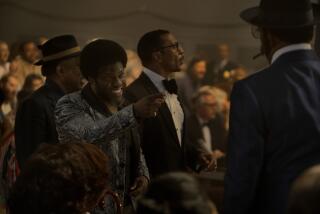TV REVIEWS : ‘Shock Video’ a Show Worth Watching
- Share via
Now that there’s one for guns, we may need a Brady Bill for camcorders: a five-day waiting period for checking backgrounds of prospective buyers of these portable cameras. Are their purposes noble or merely voyeuristic?
The problem is that such a law could violate one of our fundamental rights--the right to snoop.
Just kidding, of course, but it’s something to mull while watching “Shock Video,” the latest in a series of “American Undercover” documentaries on HBO. It airs at 9:30 tonight, examining the video revolution that has put an estimated 40 million camcorders in the hands of private citizens globally.
Although producer-directors Fenton Bailey and Ralph Barbato essentially have nothing much new to say about this now-familiar topic, they deliver a highly watchable hour.
We’re “living in the pupils of a thousand eyes,” futurist Alvin Toffler notes tonight. Many of them are focused with the highest of intentions. The dying father in the blubbery “My Life,” for example, immortalizes himself on home video for the benefit of his unborn son. And on “Shock Video,” a news cameraman documents everyday life in the Gaza Strip. A family’s hidden camera documents abuse by a baby-sitter. A gay man sets a similar trap for his viciously homophobic next-door neighbor. Once again, here is Rodney G. King. And for camera-caught performance art at its most inane, say hello to “America’s Funniest Home Videos” and its diapered partner on ABC, “America’s Funniest People.”
On another, more salacious front, a picture is worth a thousand dollars, if not more. So, as “Shock Video” notes, tabloid programs pay for amateur-shot footage, and “A Current Affair” even has supplied video commandos with cameras to videotape hookers in operation. There on the screen in a separate case is a man having sex behind his truck with a woman other than his wife. After the footage got its worldwide premiere on a local newscast, we’re told, the philandering man committed suicide.
Which, of course, is one of the problems. Videocams have extended the public eye to the heretofore hidden underbellies of government and criminal malfeasance, but they also lock that eye on private matters that should remain private.
Moreover, what even the most high-minded of this footage lacks--something that “Shock Video” fails to note--is context, atmospheric coloring, an explanation of what may have led to the pictures. Instead, too many such videos are isolated, presented in an information vacuum that skews our vision of the world.
As for the snoops, well, we have met Big Brother, and he is us.
More to Read
The complete guide to home viewing
Get Screen Gab for everything about the TV shows and streaming movies everyone’s talking about.
You may occasionally receive promotional content from the Los Angeles Times.






